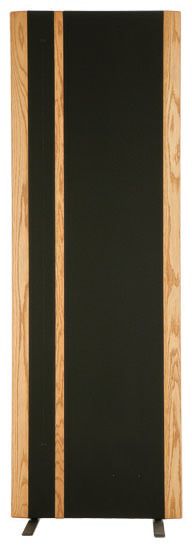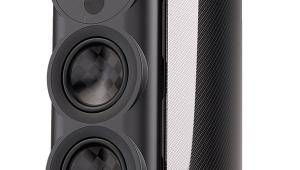Magneplanar Mg3.6r (£7500)
 Firsts linger long in the memory. That first school, first car, first kiss... and for the audiophile the thrill of owning our first truly high-end loudspeaker. Sure enough my first big box was the Dalek of loudspeakers, the KEF Reference 105, but it was the exotic Magneplanar MG2.5R that truly stole my heart.
Firsts linger long in the memory. That first school, first car, first kiss... and for the audiophile the thrill of owning our first truly high-end loudspeaker. Sure enough my first big box was the Dalek of loudspeakers, the KEF Reference 105, but it was the exotic Magneplanar MG2.5R that truly stole my heart.
Distributed in the early ’80s by Absolute Sounds, Magnepan’s ‘planar-magnetic’ loudspeakers offered the promise of electrostatic transparency with the grunt of a big moving-coil. This was my reference loudspeaker through the mid-1980s but the relationship came to a crushing halt when I moved house and these door-sized dipoles simply refused to sing so sweetly in the new listening room.
So here we are, some 20-odd years later, another house, a new and substantially bigger listening environment and the latest generation of Magnepan’s iconic loudspeakers back in the UK and longing to be re-acquainted. Or so I told myself. This could just as easily turn out to be a disaster fresh from the pages of Friends Reunited...
OPEN DOORS
Unpacking the apex of Magnepan’s MG3 series loudspeakers, I was reminded of just how heavy these 71in-tall room screens are – some 145lbs including a little cardboard and polystyrene packaging. It’s not the real wood side cheeks or the external crossover boxes that add to the bulk. Rather, it’s the huge ferromagnetic panel bolted to the rear of each mirror-image speaker and concealed behind a tasteful black cloth that causes the scales to spin.The external crossover is something of a necessity as the minimal 1.5in depth of the speakers simply won’t accommodate large air-cored inductors. But separation brings flexibility. Sure, you can simply bolt your amp cables to one end of the metal crossover box and secure the other to the bass and mid/treble connections at the base of the speaker [see picture, p26]. Magnepan’s crossover box provides a 200Hz split while a further 1.7kHz high pass section separates the ribbon tweeter in situ.
There is another set of inputs to the crossover that allows for passive bi-amping. Alternatively you might employ an active crossover/room eq system from another supplier and feed these same bass and mid/treble connections from two separate amplifiers. This more sophisticated approach will undoubtedly yield better results in most (non-ideal) listening rooms, albeit at a cost.
I cannot stress just how tricky and time-consuming these huge dipoles are to set-up. Screwing on the T-shaped feet and bolting the external crossover boxes in place takes mere minutes. But the shifting around that ensues takes hours unless you are very fortunate to hit that sweet spot first time. The sound, by which I include its response, imaging, integration and distortion at the listening position, is more a function of both room and speaker with such massive panels (radiating front and back) than it’ll ever be with more conventionally directional boxes. Fine-tuning their position and that of furniture and funishings in the room, particularly behind the panels, has a critical impact on the quality of the music at hand. An experienced dealer will be worth his weight in gold as will the value of a home demo.
One quick tip – if you listen at a distance from the MG3.6Rs then pair them with ribbon tweeters on the outside edge and then toe them with the bass panels slightly closer to you. Correct time-alignment across bass, midrange and treble sections is assured by this manoeuvre. By the same token, if you listen up-close then have the tweeter sections innermost and toe the panels inwards at a greater angle.
Also, the further you pull these dipoles away from the rear wall, the better. There are pictures on the Magnepan website of Maggies parked very close to this room boundary – an unlikely location for high quality listening. Is Magnepan anxious not to scare prospective owners away with pictures of the MG3.6R breathing easy some 2m or so into the room?
MEMORY LANE
Perhaps it was my desire to re-capture that fabulously broad, deep and immersive sound that I remembered from my audio youth that found me trawling through favourite discs from the era, CDs like Tracy Chapman’s eponymous debut that had survived 23 years without a hint of ‘laser rot’. Sourced from the digital output of a thoroughly modern Sony BDP-S5000ES BD player and driven by a Devialet D-Premier amplifier [HFN Apr ’10], the sound of her ‘Fast Car’ cruised effortlessly into the room. The juxtaposition of Chapman’s quietly urgent vocals and the Hammond organ ranged to the edges of the soundstage, with the driving attack of drums, electric guitar and percussion revealed in the varied textures and dynamics of this deceptively simple album.
The sound was undoubtedly deep and robust, if arguably better extended through bass than high treble. More complex, denser and arguably heavier mixes from the likes of Massive Attack or eclectic arrangements from Enigma fared less well. On these occasions I could not escape the feeling that some fine detail was being smothered by the blanket of mid-bass energy that thundered forward.
CLASSICAL POWER
A hallmark of most if not all Maggies is that they never sound overtly loud, just gloriously spacious. This can encourage the unwary to slowly increase their grip on the volume control, so it’s only when the music fades that you realise just how loud the music was!
Neither are the MG3.6Rs especially sensitive [see Lab Report], eagerly gobbling everything the Devaliet could muster in its support of Telarc’s choral re-imagining of Tchaikovsky’s 1812 Overture [Telarc DVD-A-70541]. You’ll need something more powerful still – a big MF or Bryston – if the swell of the horns and emphatic retort of bassoon and cannon are not to compress under the huge swings in dynamic range encompassed by this recording. This same disc sounds crisper, more incisive and dynamic, particularly at low frequencies, via my resident B&W DM802s, but even they cannot marshal the grand field of sound painted by these Maggies.
Plunging my hand deeper into the lucky dip of past glories, I withdrew Live On The Double Planet [Windham Hill 371066-2] a tour-de-force of precision fretwork from the metronomic fingers of Michael Hedges. Once again, the Maggies compelled me to gradually wind up the volume, the soundfield swelling in response, dynamics gaining potency, the resounding crack of his strings cutting the air with breathtaking power. All this confirmed my growing suspicion that the MG3.6R was a speaker better suited to highbrow rock and classical music recorded within an ample if not generous acoustic.
STORM CLOUDS
As I intimated earlier, dense rock, jazz or blues are not its bag, regardless of the resolution of the source and neither, as Magnepan suggests, because this develops a ‘hot treble’ from its ribbons. To my ears the issue has more to do with its rose-tinted perspective of the busiest multi-tracked mixes than any brightening of balance. In fact I never felt compelled to insert Magnepan’s 1ohm treble-slugging resistors into the crossover path.
My musical journey took me from Rush to Deep Purple to Alice Cooper and then to Buddy Guy/Carlos Santana’s ‘Stormy Monday’ from Blues At Montreux 2004 [ERBRD5007 Blu-ray]. The vista was never less than grand, the palette gloriously colourful but the finest detail would typically be painted with broad Renoir-esque strokes.
Emerging from the light buzz of on-stage electronics and urged by Buddy himself, the raw sound of Carlos’ electric guitar became increasingly feverish, building to a captivating tumult, a cascade of light and shade that while impressive in scale was nonetheless lacking in some subtlety and fine detailing. The very same intricacy, I’m bound to suggest, that’s clearly evident from this speaker when the going is simply less tough.
VERDICT
Despite many years of living fondly with its long-distant predecessor, this latest planar flagship could not consistently light the same musical fire. Capable of a truly huge wall of sound – and prompting ear-to-ear grins – the MG3.6R is still not a speaker for all seasons, musical tastes or, most importantly, all rooms. A home demo is essential, for if it falls into place this Maggie might change your listening life.
Originally published in the March 2011 issue


















































